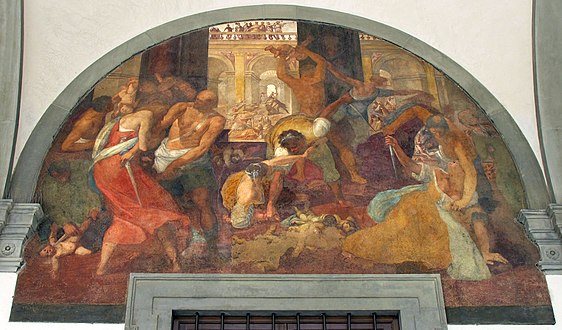Antonio Circignani

Antonio Circignani (around 1567 - around 1630 ) was an Italian painter who, like his father Nicolò Circignani and Cristoforo Roncalli, was also called il Pomarancio , although, unlike the two painters mentioned, he was not born in Pomarance .
Life
Antonio was born in Umbria near Città della Pieve around 1567 as the firstborn son of Nicolò Circignani and his wife Teodora Catalucci. He learned to paint from his father, whom he helped with numerous decorations in Rome. He is officially mentioned as Nicolò's assistant for the first time in 1589 when he frescoed the Abbey of Valvisciolo near Sermoneta .
In Città della Pieve, Antonio married Aurelia di Lodovico Fetti in February 1595, who gave birth to their first daughter the following year. When his father died (between autumn 1597 and March 1599) he became his universal heir and began his career as an independent artist.
The first work that can safely be attributed to Antonio are the frescoes with scenes from the life of Christ for the church of Santa Maria della Consolazione in Rome - they are, however, still strongly influenced by his father. This was followed by decorations in a hall and in the chapel of the Palazzo Antici Mattei (1600), which were attributed to Cristoforo Roncalli (also Pomarancio) by Titi in 1686 and later art historians , but which were clearly identified by documents newly discovered by Panofsky-Soergel in 1967-68 as the work of Antonio Circignani and P. Orsi. In these frescoes he shows himself (according to Cordaro) influenced by Cavalier d'Arpino and other artists who helped overcome late Mannerism by returning to more classic and simpler forms.
This stylistic reorientation Antonios is more evident in the Cappella di Sant 'Aniceto in Palazzo Altemps , where he worked on the walls depicting scenes from the life of St. Aniceto and in the presbytery a Marie cycle painted, and influences of Passignano , Roncalli and the young Orazio Gentileschi processed . This is followed by an examination of naturalism, Chiaroscuro and Caravaggio's light effects . This is evident in the altarpiece and the frescoes of the Cappella di Sant 'Alberto in Santa Maria in Traspontina (approx. 1610–15), where he knows how to adapt Caravaggio's influence “... even discreetly to the requirements of wall painting”.
These are the only stand-alone works in Rome that are undoubtedly created by Antonio Circignani that have survived.
Baglione (1642) also mentions decorations in Cardinal Varallo's gallery and in Palazzo Lante, as well as in Sant'Andrea della Valle and in St. Peter's Basilica , where he finished a work by his late namesake Cristoforo Roncalli - but all of these paintings have disappeared.
Antonio Circignani's work is also documented in Santa Maria Nuova in Florence and in cities such as Narni , Terni , Amelia, Spoleto , Assisi , Sezze , Modena and Urbino . The works in Umbria and in the Marches have hardly been researched up to the present day and are either not known or are in part confused with the other two Pomarancios (his father or C. Roncallis).
As an old man, shortly before his death, Antonio Circignani married Clementina for the second time on May 25, 1629, a daughter of the goldsmith Antonio Garofolini.
According to Baglione, Antonio Circignani also worked as a copper engraver .
Other well-known works are:
- Crucifixion (1620), Pinacoteca Estense in Modena (see picture above)
- Entombment of Christ (signed and dated 1625), Chiesa parrocchiale by Mondaino (near Rimini ).
- Hercules , Galleria Pallavicini, Rome
- Banquet in Emmaus , Statens Museum for Kunst , Copenhagen
- Decoration of the Altare del Gallo in the Church of Santa Maria delle Grazie, Pistoia .
Bethlehemite child murder , fresco 1614, Hospital of Santa Maria Nuova, Florence
literature
- Giulio Mancini : Considerazioni sulla Pittura… [1617–21], a cura di A. Marucchi -L. Salerno, I-II, Rome 1956-57, ad Indicem
- Giovanni Baglione : Le vite de 'pitt., Scultori et arch.… [1642], a cura di V. Mariani, Rome 1935, pp. 42, 302, 397
- Filippo Titi: Ammaestramento utile e curioso di pittura ... , Rome 1686, pp. 10, 164, 402
- Michele Cordaro: CIRCIGNANI, Antonio, detto il Pomarancio. In: Alberto M. Ghisalberti (Ed.): Dizionario Biografico degli Italiani (DBI). Volume 25: Chinzer – Cirni. Istituto della Enciclopedia Italiana, Rome 1981. (accessed February 20, 2019; main source of this article)
Web links
Individual evidence
- ↑ a b c d e f g h i j k l m n o p q Michele Cordaro: CIRCIGNANI, Antonio, detto il Pomarancio. In: Alberto M. Ghisalberti (Ed.): Dizionario Biografico degli Italiani (DBI). Volume 25: Chinzer – Cirni. Istituto della Enciclopedia Italiana, Rome 1981. (accessed February 20, 2019)
- ↑ " ... saperle (le influenze caravaggesche; author's note) persino discretamente reggere alle esigenze della decorazione murale "; quoted from Longhi, 1943; here after: Michele Cordaro: CIRCIGNANI, Antonio, detto il Pomarancio. In: Alberto M. Ghisalberti (Ed.): Dizionario Biografico degli Italiani (DBI). Volume 25: Chinzer – Cirni. Istituto della Enciclopedia Italiana, Rome 1981. (accessed February 20, 2019)
| personal data | |
|---|---|
| SURNAME | Circignani, Antonio |
| ALTERNATIVE NAMES | il Pomarancio |
| BRIEF DESCRIPTION | Italian mannerist and early baroque painter |
| DATE OF BIRTH | around 1567 |
| DATE OF DEATH | around 1630 |
| Place of death | Città della Pieve |
